Introduction: The Sizzle, The Aroma, The Chaos
Picture this: it’s 7 PM in a Beijing hutong. The narrow alley is thick with steam rising from massive woks. Vendors shout orders in rapid-fire Mandarin. The smell of sesame oil, chili peppers, and charred meat hangs in the air. Strangers stand shoulder-to-shoulder, chopsticks poised over metal plates, their faces illuminated by the glow of grilling skewers. This isn’t fine dining. This is real China.
Here’s a surprising statistic: over 80% of Western travelers say street food was their favorite memory of visiting China. Not the Great Wall. Not the Forbidden City. The street food.
Yet for first-time visitors from Europe and North America, Chinese street food can feel like stepping into another planet. What’s safe to eat? How do you actually order when you can’t speak Mandarin? Why does that pile of organs look so… happy? Isn’t eating on the street, well, dirty?
These aren’t silly questions. They’re the barriers that keep countless visitors from experiencing one of the world’s most authentic, delicious, and culturally rich food traditions. This guide is your key to unlocking that experience. By the end, you’ll move from nervous tourist to confident diner—someone who doesn’t just survive Chinese street food, but seeks it out, understands it, and craves it for years to come.
Welcome to the adventure.
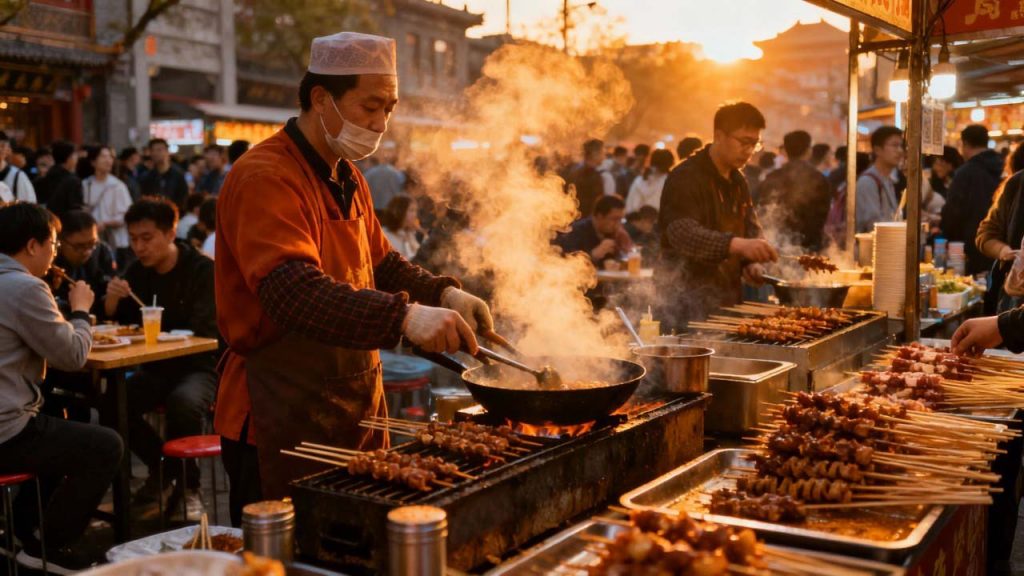
Chapter 1: Why Street Food Is the Beating Heart of Chinese Culture
Most Westerners think of street food as “cheap food.” Budget meals for people without time or money. But in China, street food is something entirely different. It’s a cultural institution.
For over two thousand years, street vendors have been the keepers of regional cuisine. Long before restaurants became fashionable, these vendors were perfecting recipes passed down through families, tweaking techniques in tiny stalls, and creating dishes so good that emperors would have them brought to the palace. Today, many of the most celebrated dishes in fine-dining restaurants originated on the street.
But it’s more than history. Street food is where Chinese social life happens. Office workers grab breakfast before their commute. Teenagers hang out after school. Families gather on weekend evenings. Business deals are negotiated over bowls of spicy noodles. These aren’t transactional moments—they’re social rituals. Street food vendors aren’t just selling food; they’re facilitating community.
This is also where the cultural collision begins for Western visitors. In the West, we’re taught to compartmentalize: fine dining is formal, fast food is convenient, and eating on the street is something we do only when desperate. The Chinese way dissolves these boundaries. A 60-year-old grandmother in designer sunglasses stands next to a construction worker; a CEO eats with his hands; people share dishes with strangers. There’s no hierarchy of occasions, no guilt about street eating, no artificial distinction between “proper” food and casual food.
There’s also the matter of what people eat. Growing up in the West, you probably learned that certain animal parts are “gross” or “not food.” Chicken is okay, but not the organs. Seafood is fine, but not sea cucumbers. Fish is good, but fish swim bladders? Come on. In China, this distinction doesn’t exist. Why waste a perfectly good piece of an animal? This philosophy—sometimes called “eating from nose to tail”—isn’t trendy. It’s thousands of years old.
For many Western travelers, this realization is uncomfortable at first. But it’s also liberating. Once you embrace it, street food stops being “weird” and becomes an entirely new way of understanding food, waste, and value. And that shift changes everything.
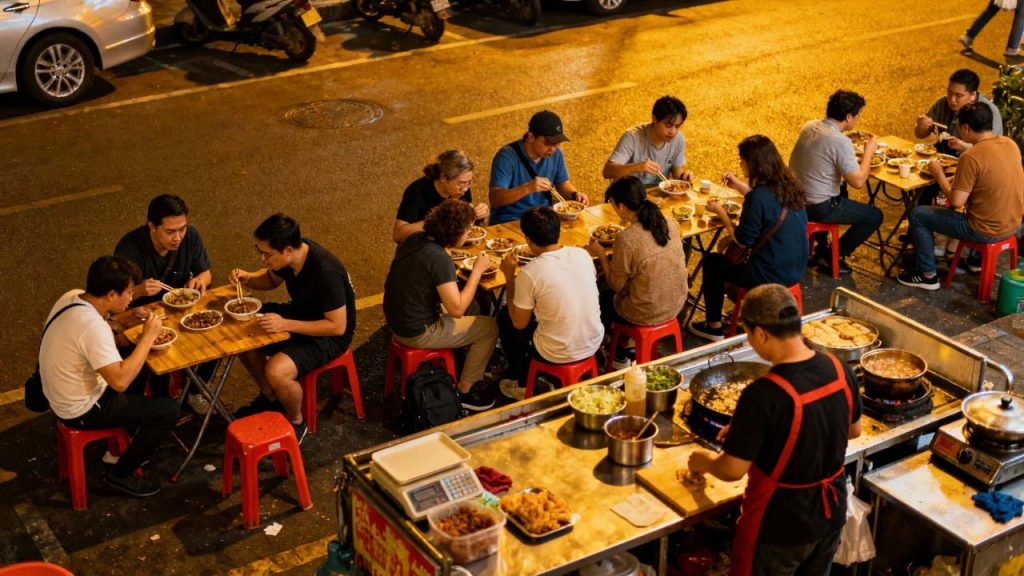
Chapter 2: Street Food Safety—What You Actually Need to Know
Let’s address the elephant in the room: Is Chinese street food safe?
The short answer: yes, generally very safe. The long answer is a bit more nuanced, but also reassuring.
Western media has created a fearsome image of Chinese street food—unsanitary conditions, questionable ingredients, mysterious ailments. The reality is that street food in major Chinese cities is far safer than you’ve probably been led to believe. That said, your stomach might still need adjustment, and smart precautions matter.
The Golden Rules: How to Choose a Safe Stall
The “Follow the Crowd” Method
This is the simplest and most effective rule: eat where the locals are eating. A stall with a line of people (during meal times) is a stall that’s moving product quickly. Quick turnover means fresh ingredients. A busy stall also means the vendor is too busy to take shortcuts. If a stall is consistently empty but the one next to it has a crowd, there’s probably a reason.
Observe the Setup
Spend 30 seconds watching the vendor. Are they preparing food with bare hands on dirty surfaces? Or do they use utensils, keep their workspace relatively organized, and wash hands between customers? This doesn’t need to be surgical precision, but you should see basic hygiene practices. Most successful street vendors understand that reputation is everything—they can’t afford to make customers sick.
Look at the ingredients too. Are fresh vegetables being used? Is meat being cooked thoroughly? Is the oil being changed or does it look like it’s been recycled twenty times? (Okay, slight exaggeration, but old oil is a red flag.)
The Freshness Test
When in doubt, ask. Learn to say “Is this fresh?” (是新鲜的吗? Shì xīnxiān de ma?) or simply point and use a questioning tone. Most vendors will be happy to explain. If meat has been sitting in the sun for hours, it might still be okay to eat—it’ll be fully cooked—but it’s better to move on.
The Invisible Rules
Stick to bottled water. Tap water in major cities is generally safe to drink (the government infrastructure is solid), but your Western gut flora isn’t used to the local microbes. Play it safe and buy bottled water from 7-Eleven or any convenience store. It’s cheaper than you’d expect and removes one variable.
Avoid raw and uncooked foods unless you’re at a very upscale place (which defeats the purpose of street food). Most street food is cooked at high temperatures—grilled, boiled, fried—which eliminates most pathogens. But salads, raw fish, or unpeeled fruit from a vendor? Skip those. Stick to cooked items.
Watch the cooking process. If you can see it being prepared, that’s actually a good sign. The vendor isn’t hiding anything. Use your eyes and nose. If something smells off, it probably is.
About Your Stomach
Here’s what many travel guides won’t tell you: your stomach might feel slightly off for a few days. This isn’t because Chinese street food is dangerous. It’s because you’re introducing new bacteria, spices, and oil levels that your digestive system has never encountered. This is completely normal, and it’s a sign that your gut is adapting, not failing.
Come prepared: Pack some antacids (Tums or equivalent) and a reliable anti-diarrheal medication (Imodium). Most pharmacies in China can also provide these over the counter if needed. Drink plenty of water. Eat smaller portions while you’re adjusting, then gradually increase.
After 2-5 days, most travelers find their stomach settles down and they can eat freely. Your microbiome is actually expanding—that’s a good thing, even if it’s uncomfortable for a moment.
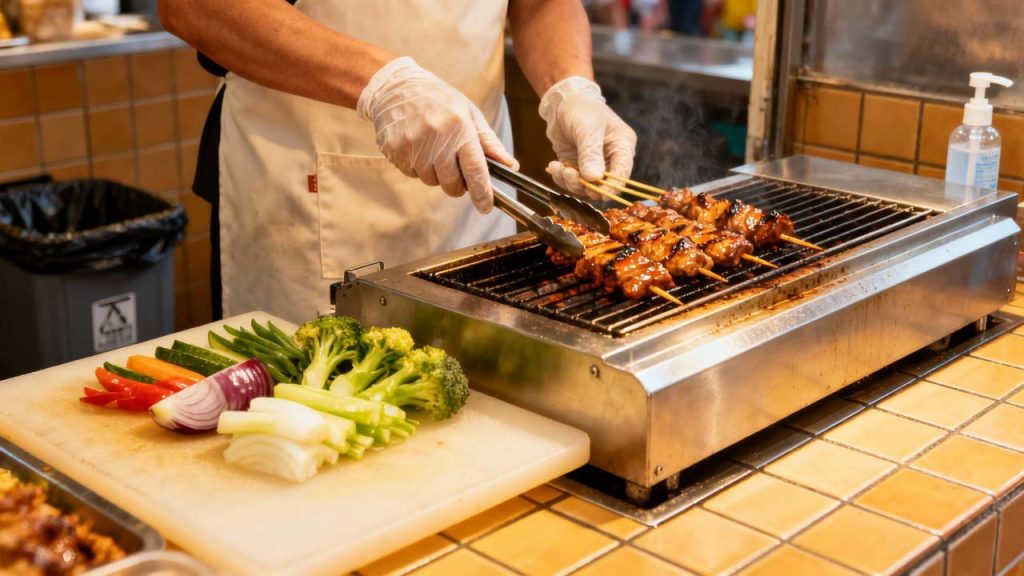
Chapter 3: How to Order Like a Local (Without Speaking Mandarin)
This section might be the most important one. Because street food vendors don’t typically speak English, ordering can feel like a high-stakes game of charades. But it’s actually simpler than you think.
The Four-Step Ordering System
Step 1: Look
Point. This is your primary tool. You’ll notice that most street food is either on display in a case, cooking in front of you, or on a menu board with pictures. Use your eyes. When you see something that looks appealing, point directly at it while making eye contact.
If there’s no visible display, watch what the person in front of you ordered and decide if you want the same.
Step 2: Ask (The Essentials)
You need exactly four phrases. Write these down in your phone, or even better, save a voice recording of a native speaker saying them (Google Translate’s audio function works fine):
- “这个” (zhège) = “This one” (or these ones). Point while saying it.
- “多少钱?” (duōshǎo qián?) = “How much?”
- “不要辣” (búyào là) = “Not spicy” (if you can’t handle heat)
- “谢谢” (xièxiè) = “Thank you”
That’s genuinely all you need for 90% of transactions.
Occasionally, you might want to ask about quantity or modifications. For multiple items, hold up fingers. If you want extra of something, repeat the point and say “再来一个” (zàilái yī gè) = “One more of that.”
Step 3: Pay
This is where 2025 makes things easier. Most street food vendors now accept mobile payments through Alipay (支付宝) or WeChat Pay (微信支付). When you arrive in China, set these up immediately—it’s often faster than cash and vendors rarely make change mistakes.
That said, carry some cash anyway (100-200 RMB to start). Not all vendors accept mobile payments, especially in smaller streets, and it gives you options.
The transaction is always straightforward: you eat/receive, they tell you the price, you pay. No surprises.
Step 4: Eat
Take your food. Find a spot (see etiquette below). Enjoy.
Street Food Etiquette (It’s Simpler Than You Think)
Most street food is designed to be eaten on the go. You grab it, move a few steps away, and eat while standing or walking. This is completely normal and acceptable.
Some vendors provide small plastic stools or standing counters where you can sit. If there’s space, sit. If there isn’t, standing is fine.
Chopstick note: If you’re not confident with chopsticks, don’t panic. Many street foods come with toothpick-like sticks for skewered items. For items you struggle with, use your hands—that’s often expected anyway. Chinese street food eating is informal.
Garbage: Always throw trash into the designated bins. Yes, it might feel disorganized, but vendors and the community care about this. Don’t just leave your plate at the stall.
Conversation: If you’re enjoying something, a smile and a thumbs up to the vendor is always appreciated. If you can manage a simple “很好吃!” (hěn hǎochī = “very delicious!”), they’ll light up. Vendors remember kind customers.
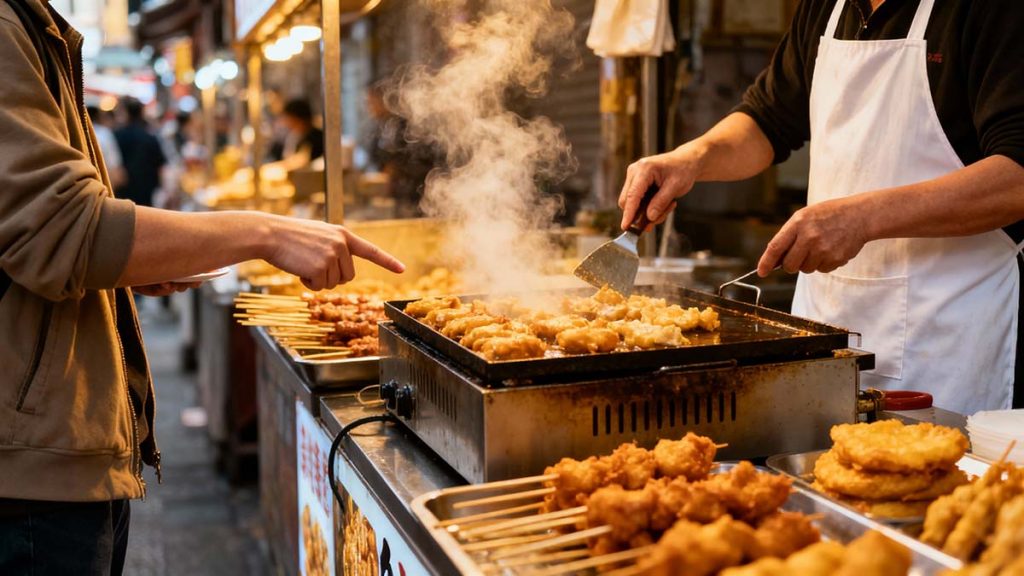
Chapter 4: The Can’t-Miss Street Food List by Region
Chinese street food varies dramatically by region. Each area has signature dishes influenced by local agriculture, climate, and history. Here’s a regional breakdown of must-tries.
Beijing: Imperial Flavors Meet Street Energy
Beijing’s street food reflects centuries of imperial kitchen influence mixed with grassroots innovation. You’ll find complex, layered flavors and a surprising sophistication in simple-looking dishes.
冰糖葫芦 (Bīngtáng húlu) – Candied Hawthorn Skewers A bright red string of hawthorn berries coated in crystallized sugar. Sweet, tangy, and refreshingly crisp. Perfect for cleansing your palate between other dishes. This is technically a snack, not a meal, but it’s iconic.
- Flavor profile: Sweet, tangy
- Where to find it: Tourist areas, temple fairs, night markets
- Why try it: It’s quintessentially Beijing, and the texture contrast is surprisingly addictive
煎饼果子 (Jiānbing guǒzi) – Crispy Crepe A savory crepe made from mung bean and wheat flour, filled with a crispy deep-fried wonton, scallions, cilantro, sauce, and sometimes an egg. Breakfast champion. Locals eat these standing up, often on their way to work.
- Flavor profile: Savory, slightly crispy, complex
- Where to find it: Early morning (5-9 AM), on any busy street
- Why try it: Breakfast that tastes like it was engineered by a flavor scientist. Your taste buds will thank you
[IMAGE PLACEMENT: Two side-by-side photos—one of candied hawthorn skewers (vibrant red), one of a jiānbing crepe being prepared. Alt text: “Beijing street food: candied hawthorn skewers and crispy mung bean crepes”]
卤煮 (Lǔzhǔ) – Braised Organ & Offal Stew This is your first real “cultural shock” moment. Kinda. Braised pork intestines, liver, and other organs in a rich, spiced broth, usually served with flatbread or rice. It sounds intimidating, but locals have been eating this for centuries. The organs become incredibly tender, and the broth is deeply savory.
- Flavor profile: Rich, savory, slightly spiced
- Cultural note: This represents the “nose-to-tail” philosophy
- Where to find it: Older neighborhoods, near hutongs
- Beginner’s tip: Start with a small portion mixed with the broth rather than eating pieces straight
Xi’an: The Ancient Silk Road Preserved in Food
Xi’an’s street food carries the legacy of the Silk Road. You’ll find influences from Muslim, Central Asian, and Han Chinese cuisines blending together.
肉夹馍 (Ròujiāmó) – Chinese “Hamburger” Tender, slow-cooked pork stewed with twenty-plus spices stuffed inside a warm flatbread that’s crispy on the outside. It’s simultaneously simple and complex. Think of it as what a hamburger would be if a Chinese grandmother designed it.
- Flavor profile: Savory, aromatic, warm spices
- Where to find it: Everywhere in Xi’an, but the best spots are in the Muslim Quarter and older neighborhoods
- Cost: Roughly 8-15 RMB ($1-2 USD)
- Why try it: Comfort food that tastes like home, even if home is on the other side of the world
羊肉泡馍 (Yángròu pàomó) – Lamb & Bread Soup This is a full experience, not just a dish. The vendor gives you a warm flatbread. You sit at a table, tear the bread into small pieces with your hands (yes, with your hands—this is part of the process), and the vendor pours hot lamb broth over it, adding tender lamb pieces, cilantro, and rice noodles. It’s interactive, filling, and tastes like 1,000 years of tradition.
- Flavor profile: Warm, aromatic, fragrant lamb, slightly spiced
- Cultural immersion factor: Very high—it’s a ritual
- Where to find it: Dedicated stalls, especially in the Muslim Quarter
- Heads up: It’s best eaten in the morning or early evening; fewer vendors late at night
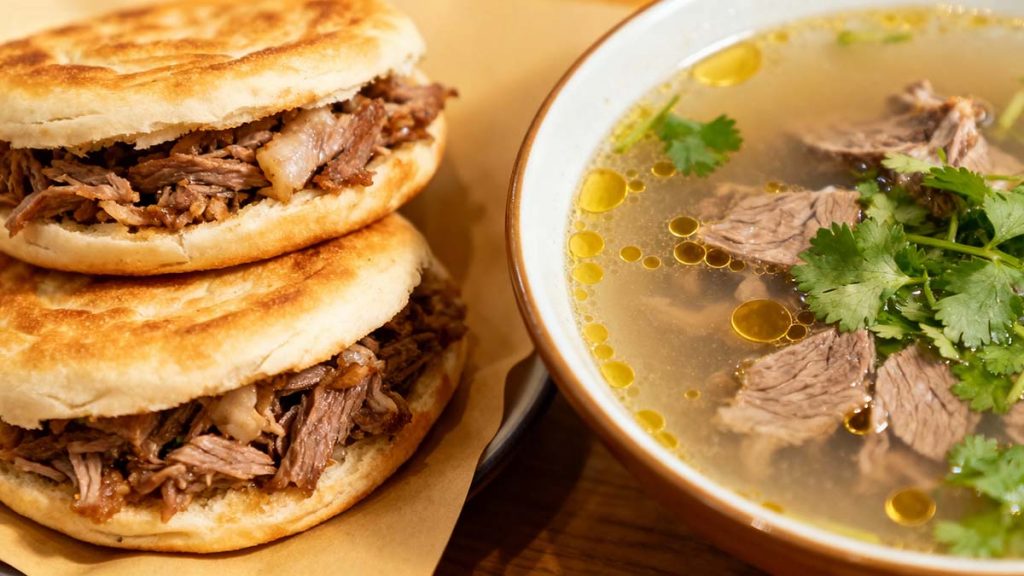
Chengdu: Embrace the Heat
Chengdu’s street food culture is built on a simple principle: if it doesn’t make your mouth numb and your sweat glands work overtime, what’s the point? Sichuan peppercorns and chili peppers are non-negotiable. But there’s method to the madness—the heat is balanced with aromatic spices and umami.
串串香 (Chuànchuàn xiāng) – Spicy Sichuan Broth Hotpot Think fondue, but spicy and anarchic. You pick individual ingredients (vegetables, meats, tofu, seafood) that are already threaded on bamboo skewers, then dip them into a bubbling pot of chili oil and Sichuan peppercorn broth at your table. It’s social, interactive, and builds community.
- Flavor profile: Spicy, numbing (from Sichuan peppercorns), complex
- Best for: Groups, adventurous eaters, evening eating
- Heat warning: Legitimate—even “mild” versions are spicy for non-Sichuan eaters
- Beginner approach: Ask for a “mild” version (不辣的 búyào là) and don’t be shy
- Social aspect: This is genuinely fun to do with other people
龙抄手 (Lóng chāoshou) – Sichuan Wontons Delicate wontons in a chili oil broth, topped with sesame oil and Sichuan peppercorns. The wrapper is paper-thin, the filling is typically shrimp and pork, and the broth packs an aromatic punch without being aggressively hot.
- Flavor profile: Spicy, numbing, aromatic
- Where to find it: Chengdu’s main streets, dedicated wonton stalls, markets
- A step down from: Chuanchuan, so try this if you want intense flavor without full participation
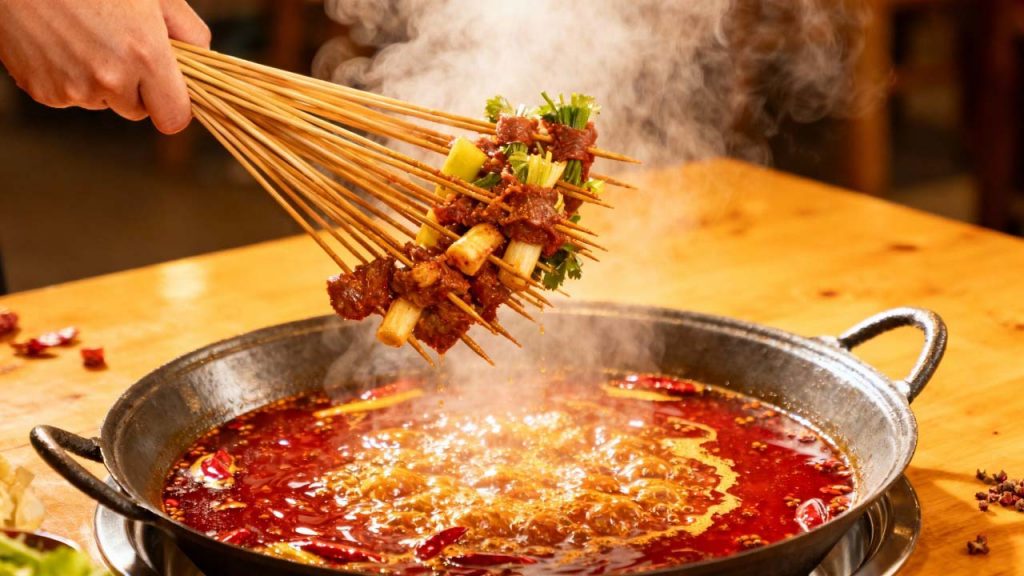
Guangzhou: Elegance in Simplicity
Guangzhou’s street food philosophy is “let the ingredient shine.” Cooking techniques are refined but minimal. You’ll find dim sum relatives, delicate preparations, and an emphasis on fresh, quality ingredients.
肠粉 (Cháng fěn) – Steamed Rice Noodle Rolls Silky, delicate rice noodles wrapped around pork, shrimp, or vegetables, served warm with soy sauce and optionally with chili sauce. It looks simple. It tastes like velvet. This is proof that sophistication doesn’t require complexity.
- Flavor profile: Delicate, savory, slightly sweet soy sauce
- Texture note: Impossibly smooth
- Where to find it: Early morning (6-10 AM), dim sum stalls, night markets
- Why try it: If you’ve ever doubted that simple food could be exceptional, this will convert you
烤乳鸽 (Kǎo rǔgē) – Roasted Young Pigeon Young pigeon (not as intimidating as it sounds) roasted until the skin is crispy and the meat is incredibly tender. It’s usually chopped into bite-sized pieces with the skin still attached, served with a simple dipping sauce. This is where you understand why Cantonese cuisine is legendary.
- Flavor profile: Delicate, savory, game-like but not gamey
- Texture: Crispy skin, tender meat
- Cultural note: This dish shows up in fancy restaurants too—it’s elevated street food
- Where to find it: Dedicated roasted meat stalls (they usually have roasted duck and chicken too)
- Logistics: Often sold by the piece, so point at the part you want
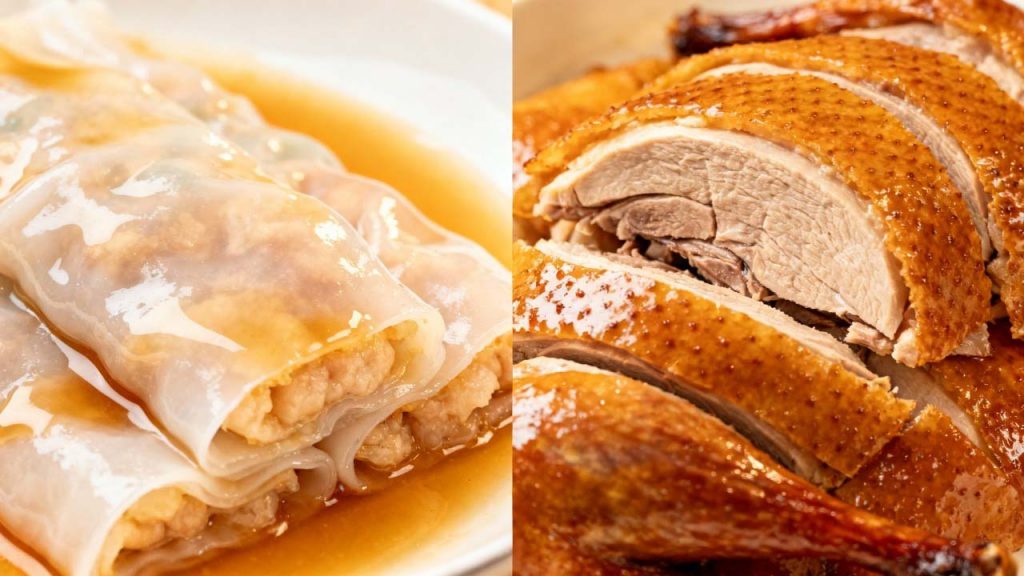
Chongqing: Xiaolongkan (小龙坎) – Spicy Crayfish Street Culture
Chongqing’s street food scene is defined by one dish: crayfish cooked in spicy oil. In summer, the city essentially becomes one giant outdoor crayfish restaurant, with vendors and casual tables lining every street.
麻辣小龙虾 (Málà xiǎolóng xiā) – Spicy & Numbing Crayfish Freshwater crayfish (similar size to crawfish) boiled in oil infused with chili peppers, Sichuan peppercorns, and garlic. You crack them open, eat the meat, and dip in sauce. It’s messy, communal, and absolutely addictive. Your fingers will get oily and orange. You won’t care.
- Flavor profile: Intensely spicy, numbing, garlicky
- Season: Best May-September (that’s when they’re available and vendors set up)
- Social factor: Extremely high—this is what people do in summer
- Where to find it: Outdoor street stalls, especially near the Jialing River
- Beginner warning: Even the “mild” versions are legitimately hot. Order accordingly
Shanghai & Jiangsu: Rich, Subtle, Slightly Sweet
Shanghai’s street food is more refined and less fiery than other regions. You’ll find an emphasis on sweetness, rich broths, and imported influences (Shanghai was a international trading hub).
小笼包 (Xiǎo lóng bāo) – Soup Dumplings These are usually found in restaurants, but street vendors sell them too. Tiny steamed dumplings with thin wrappers containing hot pork broth and finely minced pork. You pick one up with chopsticks, poke a small hole, sip the broth, and then eat the dumpling. Requires technique, but it’s worth learning.
- Flavor profile: Savory, delicate pork broth
- Where to find it: Better at dedicated stalls or restaurants than casual street vendors, but some vendors do sell them
- Why it matters: An introduction to technical eating that’s rewarding
生煎包 (Shēng jiān bāo) – Pan-Fried Pork Buns Dumplings filled with pork and aspic (meat jelly that melts when heated), pan-fried until the bottoms are crispy and golden. When you bite into them, you get a burst of savory jelly and meat, plus the textural contrast of the crispy bottom with the soft top.
- Flavor profile: Rich, savory, slightly sweet
- Texture: Crucial—crispy bottom, tender sides
- Where to find it: Breakfast stalls, morning markets
- Pro tip: The bottom should be slightly burnt—that’s intentional and delicious
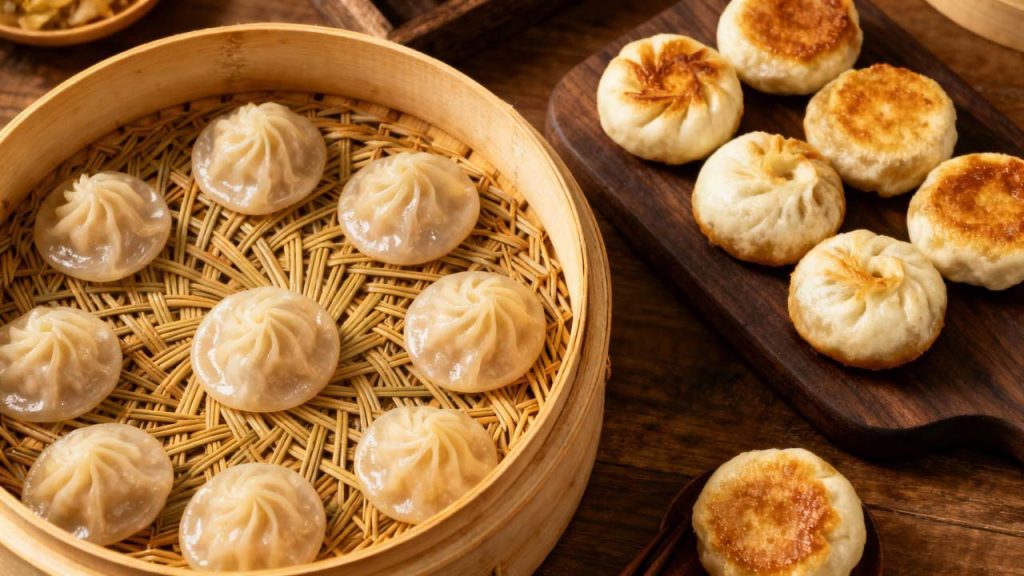
Hidden Gems: Beyond the Obvious
长沙臭豆腐 (Chángshā chòu dòufu) – Changsha Stinky Tofu Fermented tofu blocks fried until crispy on the outside, served with chili sauce. The name is literal: it smells pungent, even offensive, to the unfamiliar nose. But eat it. Most visitors report that it tastes nothing like it smells—actually savory, crispy, and oddly satisfying. This is the definition of “cultural shock as character building.”
- The challenge: Overcoming the smell
- The reward: A unique flavor and a great story
- Philosophy: “闻着臭,吃着香” (wén zhe chòu, chī zhe xiāng) = “Smells stinky, tastes fragrant.” The Changsha motto
- Where to find it: Changsha (obviously), but increasingly in other cities’ night markets
烤冷面 (Kǎo lěng miàn) – Grilled Cold Noodles An unexpected discovery from Northeast China. Cold noodles are grilled on a hot griddle until slightly crispy, then an egg is cracked onto it, plus sausage slices, scallions, and sauce. It’s fried noodles, but deconstructed and then reassembled into something new. Textural chaos in the best way.
- Why it’s “unexpected”: Most Westerners have never heard of it, and it sounds weird in theory
- Why it works: Crispy texture, egg richness, nostalgic comfort
- Where to find it: Northeast regions (Liaoning, Jilin, Heilongjiang), increasingly in university areas nationwide
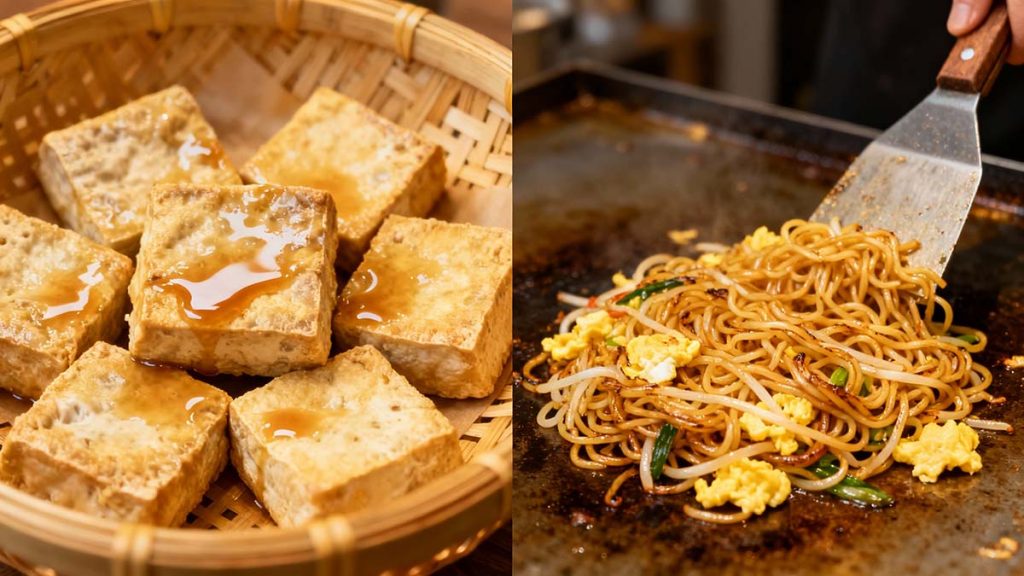
Chapter 5: “Weird” and Wonderful Delicacies—Embracing the Adventure
At some point during your trip, you’ll encounter something that makes you pause. It might be a vendor grilling chicken hearts. Or a bowl of duck blood and rice noodles. Or a whole fish head staring at you from a skewer.
This is the moment that separates people who visit China from people who experience China.
Why These Foods Aren’t Actually Weird (They’re Just Different)
In the West, we’ve artificially narrowed what we consider “food.” Chicken breast and thighs, yes. Chicken heart? Suddenly it’s “weird.” Fish fillets, acceptable. Fish head, “eww.” This isn’t based on nutrition or flavor. It’s based on marketing, habit, and the industrialization of meat production that separated us from the reality of where food comes from.
In China, this separation doesn’t exist. A chicken is a chicken, and every part has value. Every part has a flavor. This philosophy isn’t weird—it’s ancient, it’s practical, and it’s increasingly respected by chefs and food writers worldwide. (Ever heard of “nose-to-tail eating”? That’s just the trendy Western rebranding of what China’s been doing for millennia.)
The “Weird” Foods You Should Actually Try
烤鸡心 (Kǎo jī xīn) – Grilled Chicken Hearts Tender, slightly gamey, absolutely delicious when marinated and grilled. The texture is firmer than chicken meat, almost like a steak. It’s usually served on a skewer with peppers and onions.
- Flavor: Savory, slightly iron-rich, robust
- Why try it: Once you eat a properly grilled chicken heart, you’ll wonder why you ever rejected them
- Gateway food: This is often the “weirdest” thing people try before moving on to more adventurous options
烤鸭舌 (Kǎo yā shé) – Grilled Duck Tongue Delicate, tender, with an interesting textural element. It’s tiny (the size of a grape), so you get the idea without committing heavily.
- Flavor: Mild, gamey, slightly umami
- Texture fun: Completely different from meat—almost velvety
- Pro move: Try this at a serious skewer vendor; amateur vendors don’t handle it well
猪头皮 (Zhū tóu pí) – Braised Pork Head Skin Gelatinous pork skin braised until it’s tender and infused with flavor, usually served with chili oil. It’s gained popularity among trendy chefs and is genuinely interesting—the texture is unlike anything in Western cooking.
- Texture: Wobbly, slightly gelatinous, satisfying
- Flavor: Savory, neutral—it takes on the flavor of its sauce
- Where it’s common: Sichuan and Hunan regions, increasingly in major cities
猪蹄 (Zhū tǐ) – Braised Pig’s Trotters Pork knuckles slow-cooked until the collagen breaks down and the meat becomes fall-off-the-bone tender. Rich, savory, and genuinely comforting. This is less “weird” and more “why didn’t we keep eating this?”
- Why it matters: High collagen content—this is actually nutritious and has been used in traditional medicine for centuries
- Flavor: Deep, savory, slightly gelatinous
- The turning point: Many visitors who try this become advocates
鸭血 (Yā xiě) – Duck Blood Cake Coagulated duck blood formed into blocks, then sliced and served in soup or stir-fried. It looks more intimidating than it tastes. The flavor is mild, slightly iron-rich, and the texture is tofu-like.
- First impression: “Okay, this is definitely weird.”
- Second bite: “Actually… it’s kind of neutral?”
- Third bowl: “I’m getting another bowl.”
- Where it’s common: Chongqing, Sichuan, served in hotpot and soups
兔头 (Tù tóu) – Braised Rabbit Head A whole rabbit head, braised until tender, served with spices. The meat around the cheekbones and behind the eyes is tender and flavorful. This requires some work (you have to navigate around bones), but locals seek it out.
- The experience: This is full “cultural immersion”—you’re eating what locals eat
- Flavor: Gamey, tender, aromatic
- Where it’s common: Sichuan restaurants and street stalls (Chengdu especially)
The Psychology of “Weird” Food
Here’s what usually happens: you decide to try something exotic. You approach it with dread. You take a bite. Your brain says, “That’s… actually okay.” And then one of two things occurs:
Either you feel a sense of accomplishment and pride (you did it!), or you genuinely enjoy it and want more.
Either way, you’ve expanded. You’ve challenged yourself. And you’ve understood Chinese food culture on a level that guidebooks can’t teach.
Also, here’s a secret: many of these “weird” foods are actually delicious. Chicken hearts are becoming trendy in Western restaurants. Fish head is prized in high-end Asian cuisine. These aren’t weird—they’re just unfamiliar. Once familiar, they’re delicious.
Chapter 6: Mistakes Western Travelers Make (And How to Avoid Them)
After years of reading traveler reviews and forums, certain patterns emerge. Here are the most common mistakes visitors make at street food stalls—and how to sidestep them.
Mistake #1: Using a Bank Card Instead of Mobile Payment
You search for an ATM, withdraw cash, go to a street vendor with a line of people behind you, and then realize they don’t take cards. Queue anxiety ensues.
The solution: Download Alipay (支付宝) or WeChat Pay (微信支付) before you arrive. Link them to your foreign debit card. Done. Most vendors prefer mobile payment—it’s faster, reduces counterfeit currency risk, and they don’t need change. You’ll often get through faster than vendors accepting cash.
Backup plan: Carry 100-200 RMB in cash anyway for vendors in older areas or small neighborhoods that haven’t gone digital.
Mistake #2: Overthinking Safety Until You Miss Everything
You arrive in Beijing. You’re terrified of getting sick. So you eat at Western chain restaurants and safe hotel cafes. You return home having experienced zero authentic Chinese street food.
This happens more often than you’d think.
The reality check: You’re more likely to get sick from improper hotel food preparation than from a busy street vendor. Street vendors depend on reputation—one outbreak and their business collapses. Hotels? They can hide problems.
The strategy: Use the “follow the crowd” and basic observation methods from Chapter 2. Then commit. Eat at a vendor with a line. Order something popular. Enjoy it. Your gut will adapt, and you’ll create memories that chain restaurants simply can’t offer.
Mistake #3: Being Too Shy to Use Your Hands
Many Westerners are conditioned to believe that eating with your hands is improper. So you struggle with chopsticks for a dumpling designed to be hand-held, or you refuse to eat a skewer because picking it up feels crude.
Permission granted: Most street food is meant to be eaten with your hands. Skewers? Hands. Buns? Hands. Dumplings? Hands, or chopsticks if you prefer. Chinese street food etiquette is informal. Vendors actually find it charming when Westerners embrace it.
Pro tip: Bring wet wipes or napkins. Streets can get messy. Vendors sometimes provide napkins; sometimes they don’t.
Mistake #4: Going to Famous Tourist-Packed Stalls at Peak Times
You read that “Stall X in Night Market Y is the best jiānbing in Beijing.” So you show up at 7 PM expecting perfection.
What you actually find: a 40-minute line, rushed vendors, lower quality because they’re overwhelmed, and tourists everywhere taking photos.
The smarter play: Research the same dish at less-famous stalls. Go during off-peak times (2-4 PM or 10-11 PM, depending on the food). You’ll get better quality, faster service, and an authentic experience without the Instagram crowds. The second-best jiānbing vendor is still amazing, and you won’t wait an hour.
Alternatively: Ask locals. A quick question in your hotel or at a subway station—”Where’s the best street food around here?”—will yield recommendations that aren’t in guidebooks. Locals know the real gems.
Mistake #5: Not Asking About Spice Levels
You order something that looks mild. It arrives with four alarm bells’ worth of heat.
Chinese “mild” and Western “mild” are not the same. Sichuan peppercorns numb your mouth. Chili oil is genuine lava. A dish that locals consider “just a little spicy” can flatten unprepared palates.
The phrase: “不要辣” (búyào là) = “Not spicy” or “微辣” (wēi là) = “Mildly spicy.” Point at these words on your phone or write them down.
Reality check: Even asking for “not spicy,” you might get more heat than you expect. If you can’t handle spice, stick to Northern China (Beijing, Xi’an) where the food is flavorful but not fire-based.
Mistake #6: Wandering into a Stall Clueless Without Observation
You see a crowded vendor. You have no idea what they serve. You panic and point randomly.
The better way: Spend 30 seconds observing. What are other customers ordering? What does the display show? Is it sweet, savory, spicy? What’s the workflow? Then decide. This prevents both disappointment and awkwardness.
Bonus: Watching the preparation often teaches you how to eat it. You see someone tear up a jiānbing? Now you know it’s designed to be torn. You see someone crack open a crayfish? Now you understand the process.
Mistake #7: Refusing to Try “Weird” Foods and Then Regretting It Later
This is less a “mistake” and more a missed opportunity. Years later, you’ll think, “I wish I’d been braver.”
The reframe: You’re not in China permanently. Every single street vendor visit is a limited-time opportunity. Even if something tastes terrible, you’ve got a story and you’ve expanded your palate. And statistically, 70% of the time you’ll actually enjoy it.
The lowball approach: If you’re nervous, ask for a small portion. Point at a small skewer of chicken hearts instead of ordering a full plate. Commit to one adventurous bite per meal. By the end of your trip, you’ll have tried 10-15 new things.
Chapter 7: Regional Street Food Mistakes & Where to Eat
Common mistake by region:
Beijing: Eating at the “most famous” spots in Donghuamen Night Market, then complaining it’s touristy and expensive. Solution: the actual best street food is in hutongs near residential areas, not tourist markets.
Shanghai: Expecting authentic working-class street food in the city center. Most has been polished, priced up, or moved to food courts. Solution: head to outer districts (Pudong’s residential areas, Minhang) for real vendors.
Xi’an: Rushing through the Muslim Quarter at night. You’ll get decent food, but it’ll be packed and overpriced. Solution: go midday (10 AM-2 PM) when locals eat, fewer crowds, better vendors, same prices.
Chengdu: Underestimating the spice levels. Even “mild” chuanchuan will challenge your palate. Solution: either build tolerance gradually or stick to non-Sichuan cuisine for one or two meals to give your mouth a break.
Sichuan Peppercorns Explained: Why Your Mouth Goes Numb (And Why You’ll Love It)
Chongqing: Missing crayfish season (May-September). Going in winter expecting fresh vendors means disappointment. Solution: if you’re visiting off-season, ask about frozen crayfish (still good, but less of an event).
Chapter 8: Planning Your Street Food Crawl—The Practical Guide
Best Times to Eat Street Food
Early Morning (6-10 AM): Breakfast items dominate. Jiānbing, xiaolongbao, scallion pancakes, rice porridge. Vendors are fresh, energetic, and food is being made to order.
Lunch (11 AM-2 PM): Peak hours for lunch crowds. All categories of street food available. Lines form, which is good (follow the crowd), but you might wait.
Afternoon Slump (2-5 PM): Quiet time. Shorter lines, vendors less rushed, good time to explore. Some stalls close during this period, but many stay open.
Evening/Night (6 PM-11 PM): Peak social eating. The full experience—crowds, energy, atmosphere. This is when street food culture happens. Lines are longer, but it’s worth it for the vibe alone.
Late Night (11 PM-2 AM): In major cities, night markets keep going. Skewers, noodles, cold dishes. Atmosphere is more casual, drunken, fun—college students and night owls. Great energy, slightly chaotic.
The 3-Day Street Food Itinerary Template
If you’re in a major city for just a few days, here’s how to maximize:
Day 1: Breakfast + Lunch
- Early morning: try a breakfast specialty (jiānbing in Beijing, xiaolongbao in Shanghai)
- Lunch: try a regional star (roujiamo in Xi’an, chuanchuan in Chengdu)
- Evening: casual meal, recover from novelty
Day 2: Lunch + Evening Market
- Lunch: try a second major dish from a different neighborhood
- Late afternoon: explore a new market area
- Evening: full street food market experience (multiple stalls, social eating)
Day 3: Deep Dive
- Lunch: try something “weird” (offal, unusual proteins)
- Evening: return to your favorite stall from Day 1 or 2
- Night: casual snacking, whatever calls to you
Rule: Don’t eat every meal at street stalls. Your stomach needs breaks. Mix in one restaurant meal, one hotel meal. This pacing prevents digestive rebellion and keeps your palate fresh.
Best Cities for Street Food (Ranked)
Tier 1 (Must-Visit for Street Food):
- Chengdu: Spicy, adventurous, incredible variety, very affordable
- Xi’an: Authentic Muslim Quarter experience, cultural significance, historical depth
- Beijing: Iconic dishes, enormous night markets, centuries of tradition
Tier 2 (Excellent):
- Shanghai: Elegant street food, dumplings, upscale stalls, cosmopolitan mix
- Chongqing: Crayfish culture, spicy everything, unique regional identity
- Hangzhou: West Lake atmosphere, fresh ingredients, lighter flavors
Tier 3 (Good but More Specific):
- Nanjing, Wuhan, Changsha, Kunming: Each has specialties, but less “iconic” overall scene
- Guangzhou: More dim sum focused than street food-focused (though both exist)
What to Bring
- Phone with translation app (Google Translate’s camera feature is invaluable)
- Small notebook + pen (write down favorite stalls, addresses, favorite dishes)
- Wet wipes (essential after eating with hands)
- Antacids & anti-diarrheal meds (even if you don’t need them, having them = peace of mind)
- 1-2 days of medications you take regularly (street food disruption is real)
- Cash + mobile payment apps (100-200 RMB cash minimum)
- Phone charger (map navigation exhausts batteries)
Conclusion: This Is Real China
When you’ve eaten street food in China—real street food, standing in a crowd, surrounded by the smell of woks and chili oil, your fingers slightly oily, your taste buds confused and delighted—you’ve experienced something that chain restaurants and sanitized tourist tours can’t offer.
You’ve seen how ordinary people feed themselves. You’ve understood regional pride through flavor. You’ve challenged your assumptions about what food “should” look like. You’ve probably been a little uncomfortable, and you’ve probably discovered that discomfort was actually growth.
Street food is the beating heart of Chinese culture. It’s where the country’s regional identity, history, pragmatism, philosophy, and joy converge on a metal grill or in a bubbling pot.
Most importantly: it’s accessible to you. You don’t need reservations, fancy clothes, or fluency in Mandarin. You need curiosity, the phrase “这个” (zhège), and willingness to embrace the chaos.
Ready to Start Your Adventure?
Next steps:
- Bookmark this guide and save it offline (spotty WiFi in some night markets)
- Explore our comprehensive city guides—[Beijing Food Guide: 15 Must-Try Local Dishes for First-Time Visitors], [Chengdu Food Guide: 15 Must-Try Spicy Sichuan Dishes for First-Time Western Visitors]
Going to China soon? Share this guide with your travel partner. The best street food experience is a shared one.
- How to Use WeChat Pay & Alipay as a Tourist in China
- Beijing Night Markets: Complete Neighborhoods & Stall Guide
- Xi’an Muslim Quarter Food Tour: Step-by-Step Walkthrough
- Chinese Food Etiquette for Travelers: 10 Rules to Know
- Best Street Food Markets by City: 2025 Updated Guide
- Regional Chinese Cuisine Explained: The 8 Major Food Cultures
